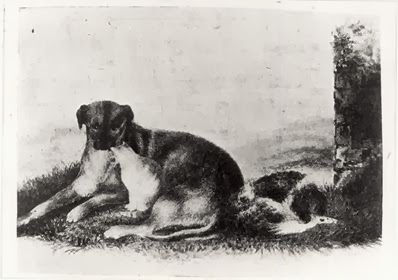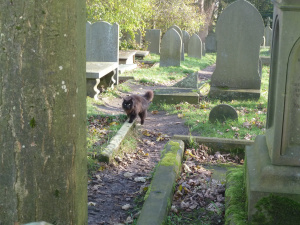Today is International Cat Day, so it seems a perfect opportunity to take a look at the cat in the lives of the Brontë sisters! The wet nosed four legged friends of the Brontës are well known, and visitors to the Brontë Parsonage Museum can still see the collars of Grasper, Keeper and Anne Brontë’s beloved spaniel Flossy, a gift from her pupils in the Robinson household. Their cat, Tom, however is not as well known.
Tom was a black cat that was doted upon by the Brontë siblings, and it seems that he certainly knew how to charm visitors to the Parsonage, probably with the intention of gaining a cuddle or even a tasty morsel or two. The world may change, but cats never change!
We have three pieces of evidence for the Brontës love of cats. First is this picture that Emily Brontë painted, with their tabby cat Tiger taking centre stage along with Keeper and Flossy:

We also see a cat taking a major role in the early part of Agnes Grey, the début novel of Anne Brontë that was heavily influenced by her real life experiences. Agnes wants to be given more to do in the northern Parsonage where she lives, but her over protective family tell her:
‘Go and practice your music, or play with the kitten.’
When Agnes leaves home to become a governess for the first time, she seeks out this kitten for special attention:
‘I rose, washed, dressed, swallowed a hasty breakfast, received the fond embraces of my father, mother, and sister, kissed the cat – to the great scandal of Sally, the maid – shook hands with her, mounted the gig, drew the veil over my face, and then, but not til then, burst into a flood of tears.’
It’s easy to imagine Anne painting this season from memory, with Aunt Branwell playing the part of mother, and Tabby Aykroyd as Sally.
There’s another sign of Anne’s fondness for cats later in the book. In a moving and tender section, the poor old woman Nancy is worried because her cat has gone missing, and she fears the local gamekeeper will have shot it. Indeed that would have been its fate, but Reverend Weston rescues it and returns it to Nancy.
We also have an eyewitness account of the Brontë cat from Ellen Nussey’s report of 1833:
‘Black ‘Tom’, the tabby, was everybody’s favourite. It received such gentle treatment it seemed to have lost its cat’s nature, and subsided into luxurious amiability and contentment.’
It’s important to note here that Ellen, always a careful and fastidious writer, has put ‘Tom’ in quotation marks, meaning that this was the name that the Brontës had given it, rather than it being simply a tom cat.
Ellen goes on to explain that Aunt Branwell was rather less fond of pets, but on this particular point the Brontë girls would not be lectured to. We’ll return to our second part of the Aunt Branwell blog this weekend, looking at her relationship with Charlotte, Branwell, Emily and Anne Brontë, but as an animal lover myself I couldn’t let International Cat Day go by uncelebrated.
By the way, if you’re lucky enough to visit Haworth today, you’re sure to see a cat or two. One in particular hangs around the graveyard in front of the parsonage, its bright eyes gleaming out of the dark. That’s it at the top of this post. As it was in the 1840s, so it is today.
